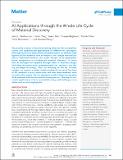| dc.contributor.author | Li, Jiali | |
| dc.contributor.author | Lim, Kaizhuo | |
| dc.contributor.author | Yang, Haitao | |
| dc.contributor.author | Ren, Zekun | |
| dc.contributor.author | Raghavan, Shreyaa | |
| dc.contributor.author | Chen, Po-Yen | |
| dc.contributor.author | Buonassisi, Tonio | |
| dc.contributor.author | Wang, Xiaonan | |
| dc.date.accessioned | 2021-12-14T19:07:00Z | |
| dc.date.available | 2021-12-14T19:07:00Z | |
| dc.date.issued | 2020 | |
| dc.identifier.uri | https://hdl.handle.net/1721.1/138475 | |
| dc.description.abstract | © 2020 The Authors We provide a review of machine learning (ML) tools for material discovery and sophisticated applications of different ML strategies. Although there have been a few published reviews on artificial intelligence (AI) for materials with an emphasis on a single material system or individual methods, this paper focuses on an application-based perspective in AI-enhanced material discovery. It shows how AI strategies are applied through material discovery stages (including characterization, property prediction, synthesis, and theory paradigm discovery). Also, by referring to the ML tutorial, readers can acquire a better understanding of the exact functions of ML methods in each application and how these methods work to realize the targets. We are aiming to enable a better integration of AI methods with the material discovery process. The keys to successful applications of AI in material discovery and challenges to be addressed are also highlighted. Advances in artificial intelligence (AI), especially machine learning (ML), provide enormous tools for processing complex data generated from experimental and computational materials research. With the rapid development of AI methods and the complex nature of interdisciplinary research, a challenge is posed as for which methods to choose for different material systems or context and which steps of the material discovery process would stand to benefit. This paper answers these questions by first introducing ML methods from a material study perspective in a tutorial section. We then discuss how AI can assist in each step through the whole life cycle of material discovery (including characterization, property prediction, synthesis, and theory paradigm discovery) by conducting a thorough literature review in the material application section. Finally, future research efforts should focus on in-depth understandings of descriptors, materials’ ML methods, data-driven application strategies, and integration of studies. | en_US |
| dc.language.iso | en | |
| dc.publisher | Elsevier BV | en_US |
| dc.relation.isversionof | 10.1016/J.MATT.2020.06.011 | en_US |
| dc.rights | Creative Commons Attribution-NonCommercial-NoDerivs License | en_US |
| dc.rights.uri | http://creativecommons.org/licenses/by-nc-nd/4.0/ | en_US |
| dc.source | Elsevier | en_US |
| dc.title | AI Applications through the Whole Life Cycle of Material Discovery | en_US |
| dc.type | Article | en_US |
| dc.identifier.citation | Li, Jiali, Lim, Kaizhuo, Yang, Haitao, Ren, Zekun, Raghavan, Shreyaa et al. 2020. "AI Applications through the Whole Life Cycle of Material Discovery." Matter, 3 (2). | |
| dc.contributor.department | Singapore-MIT Alliance in Research and Technology (SMART) | |
| dc.contributor.department | Massachusetts Institute of Technology. Institute for Data, Systems, and Society | |
| dc.contributor.department | Massachusetts Institute of Technology. Department of Mechanical Engineering | |
| dc.relation.journal | Matter | en_US |
| dc.eprint.version | Final published version | en_US |
| dc.type.uri | http://purl.org/eprint/type/JournalArticle | en_US |
| eprint.status | http://purl.org/eprint/status/PeerReviewed | en_US |
| dc.date.updated | 2021-12-14T19:00:07Z | |
| dspace.orderedauthors | Li, J; Lim, K; Yang, H; Ren, Z; Raghavan, S; Chen, P-Y; Buonassisi, T; Wang, X | en_US |
| dspace.date.submission | 2021-12-14T19:00:10Z | |
| mit.journal.volume | 3 | en_US |
| mit.journal.issue | 2 | en_US |
| mit.license | PUBLISHER_CC | |
| mit.metadata.status | Authority Work and Publication Information Needed | en_US |
